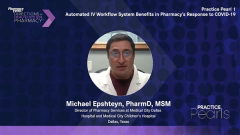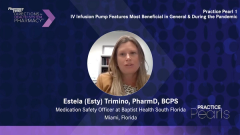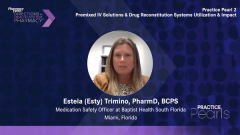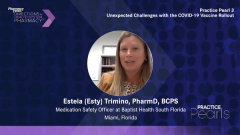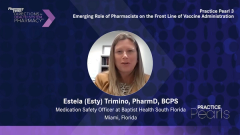
Practice Pearl 1: Impact and Management of Drug Shortages During the Pandemic
Health system pharmacists discuss the impact and management of drug shortages, such as fentanyl, midazolam, and propofol, at their institutions during the pandemic.
Episodes in this series

Madeline Camejo, PharmD, MS: Michael, what was the impact of any of the drug shortages, especially fentanyl, propofol, and midazolam, that we had during the COVID-19 crisis? How are they being managed at your institution during this pandemic?
Michael Epshteyn, PharmD, MSM:Yes, that was one of the biggest challenges, balancing out having enough medication to take care of patients when a lot of supplies were dwindling. We were a little bit at an advantage here in Texas because, if you all remember, New York was the epicenter of the COVID-19 spike first. We started hearing reports that drugs like fentanyl, Versed [midazolam], and propofol, which are used for sedation at pretty high doses in patients with COVID-19, that those drugs were becoming in short supply. We implemented several strategies. Of course, we tried to purchase what we could so that we had a good amount of inventory. But of course, that was challenging because there wasn’t enough to purchase, and a lot of these products went on allocation. Then we met with our intensivist physicians and worked out protocols where oral medications would be used as baseline coverage to conserve the use of IV [intravenous] medications. That’s what allowed us to never run out, even though we came close a few times. Then we had all the smart reports and smart systems starting with the pharmacy software, the IV workflow software, and pumps, and then putting all that information together and monitoring how many patients we had in house using each of the products. We had daily and weekly inventory updates where we were monitoring our inventory of key products carefully.
Then lastly, it’s always helpful to have a network. We’re fortunate to be one of the facilities within the larger integrated delivery network, and we have other organizations in our area where we exchange best practices and help each other with shortages. That was helpful to stay on top of inventory but also keep communication going so that you can preemptively deal with it versus having an emergent situation where you find out you don’t have any medication and you don’t have a backup plan. We always had a backup plan and worked with our sister facilities in dealing with these shortages. But I would say it was probably one of the largest challenges of the COVID-19 pandemic, shortages of selected agents that were in much higher demand than they would normally be, and also, they weren’t optional. They were all required.
Madeline Camejo, PharmD, MS: I’m going to ask the same for you, Esty. I know we used similar protocols to what Michael had done at [Medical City Dallas Hospital]. For us [at Baptist Health South Florida], we became the second epicenter...it was probably New York, Miami, and then California. We were struggling quickly within a couple of months right after New York. Etsy, why don’t you tell us a little bit of what Baptist Health did down here in Florida.
Estela (Esty) Trimino, PharmD, BCPS: Yes. We did a lot of the things that Michael did, Madeline, in our system. But one of the things that helped us quite a bit, especially with fentanyl and our drips in the ICU [intensive care unit], was we extended the beyond use dating of some of these products. We had a 24-hour change of tubing. With our IV [intravenous] pumps, at the beginning when we had the PPE [personal protective equipment] shortage and we were having all these challenges in trying to get PPE for our nurses, we did go to extended tubing, where we had our pumps outside of the rooms. In those areas, we didn’t want to change or lose the medication in that tubing. We worked with infection control, with nursing, and changed some of our policies due to the pandemic and changed some of these to have an extended time. If there was a drug remaining like, say, fentanyl or any other medication like a paralytic, a sedative, any of these drugs in shortage, we would allow it to stay for a different time frame than what was usually in practice. Where the shortage was, we worked on order sets as well…and would move the products around in our order sets depending on what was there and what the physicians were seeing. And we would work with our volumes. It was ever changing because not all the hospitals had the same shortages at the same time within the system.
We were working with our buyers, our pharmacy buyers, our pharmacy directors, our supply chain team, on what we could get and what products we had. We did a lot, similar to what Dallas did. We looked also at our infusion times and went to a lot of IV push on some of our medications to conserve some of our tubing. We looked at optimizing our dosing and days of therapy so we didn’t have to have certain antibiotics for longer days. We made sure that we were working on some of those pieces in that population, in the COVID-19 population as well. There were lots of challenges with the shortages. It was difficult to navigate, but we were trying to make it work with what products we had.
Transcript edited for clarity.
Newsletter
Stay informed on drug updates, treatment guidelines, and pharmacy practice trends—subscribe to Pharmacy Times for weekly clinical insights.

